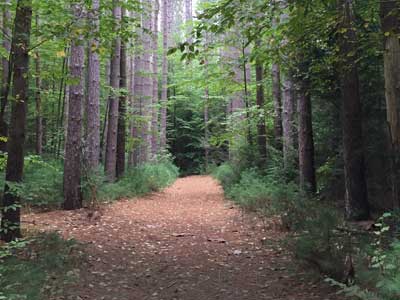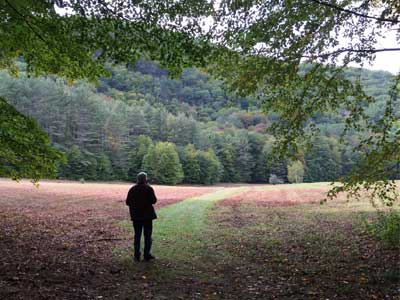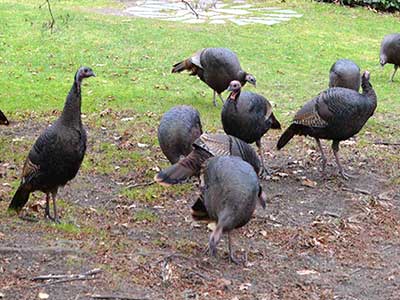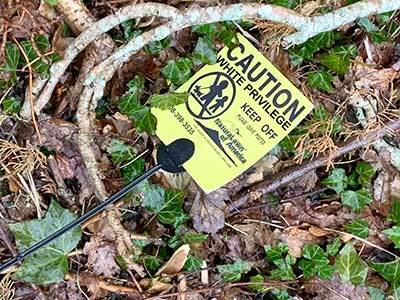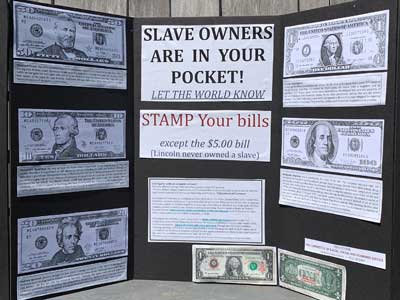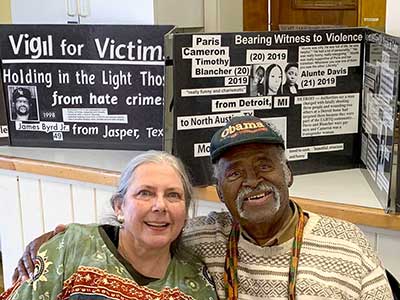by David Rosen | January 2021
When recalling Lincoln, many New Yorkers may remember the famous speech he gave at Cooper Institute (aka Cooper Union) in February 1860 calling to limit the extension – but not the end – of slavery. It was a critical campaign speech that helped him secure the Republican Party nomination for President. In November, he was elected, and, in December, South Carolina was the first state to secede from the Union.
Unfortunately, few American – and likely very few New Yorkers – will recall that Lincoln’s speech was strongly attacked by city business leaders and the Democratic Party, many assailing him with the racist slogan, “Black Republican.” More important, Lincoln’s election sparked a strong movement in the city, led by Mayor Fernando Wood, to join the South and secede from the Union. This is one of the many important historical stories retold in an informative new book by Jonathan Daniel Wells, The Kidnapping Club: Wall Street, Slavery and Resistance on the Eve of the Civil War (Bold Type Books). Slavery was formally abolished in New York State in 1827, but the slave trade lived on in the city until the Civil War. Wells argues that the slave trade persisted in New York City in the decades before the Civil War because it was the capital of the Southern slave economy.
TAGS: [Strategies] [2020’s] [History] [Civil War] [Slavery] [Politics] [Social Justice] [Policing] [Black Lives Matter] [Justice System] [White Supremacy] [White Culture] [Silencing POC] [Racial Terrorism] [Social Justice]
Resource Links Tagged with "Silencing POC"
Retracing Slavery’s Trail of Tears; America’s Forgotten Migration – the Journeys of a Million African-Americans from the Tobacco South to the Cotton South
by Edward Ball | November 2015
“My grandfather went to the folks who had owned our family and asked, ‘Do you have any documentation about our history during the slave days? We would like to see it, if possible.’ The man at the door, who I have to assume was from the slaveholding side, said, ‘Sure, we’ll give it to you.’ When Delores McQuinn was growing up, her father told her a story about a search for the family’s roots. He said his own father knew the name of the people who had enslaved their family in Virginia, knew where they lived—in the same house and on the same land—in Hanover County, among the rumpled hills north of Richmond.“The man went into his house and came back out with some papers in his hands. Now, whether the papers were trivial or actual plantation records, who knows? But he stood in the door, in front of my grandfather, and lit a match to the papers. ‘You want your history?’ he said. ‘Here it is.’ Watching the things burn. ‘Take the ashes and get off my land.’ “The intent was to keep that history buried,” McQuinn says today. “And I think something like that has happened over and again, symbolically.”
TAGS: [Racial Terrorism] [2010’s] [History] [Slavery] [Silencing POC] [Confederate Monuments] [Politics] [Black Lives Matter] [Definitions] [White Supremacy] [White Culture] [White Privilege] [Social Justice] [Civil War] [Accountability]
A Forgotten Black Founding Father; Why I’ve Made it My Mission to Teach Others about Prince Hall
by Danielle Allen | March 2021
Many of us who live in Massachusetts know the basic outlines of this story and the early role the state played in standing against enslavement. But told in this traditional way, the story leaves out another transformative figure: Prince Hall, a free African American and a contemporary of John Adams. From his formal acquisition of freedom, in 1770, until his death, in 1807, Hall helped forge an activist Black community in Boston while elevating the cause of abolition to new prominence. Hall was the first American to publicly use the language of the Declaration of Independence for a political purpose other than justifying war against Britain. In January 1777, just six months after the promulgation of the Declaration and nearly three years before Adams drafted the state constitution, Hall submitted a petition to the Massachusetts legislature (or General Court, as it is styled) requesting emancipation, invoking the resonant phrases and founding truths of the Declaration itself.
TAGS: [Assumptions] [2020’s] [History] [Role Model] [Black Lives Matter] [Slavery] [Teachers] [Silencing POC] [-ing While Black] [Advocacy] [Systemic Racism] [Social Justice] [Civil War]
The Violent History of White Supremacy Is Rarely Taught in Schools. It Should Be.
by Corey Mitchell | January 2021
Searing images from this month’s mostly white insurrection in Washington, D.C.—including a hangman’s noose on the Capitol grounds and the Confederate flag carried inside the U.S. Capitol—harken back to another era when both were tools and symbols of white supremacy across the country. But relatively few students have learned about previous sordid moments that foreshadowed this year’s efforts to instill terror and violently overturn an election such as the Wilmington Insurrection of 1898, widely thought to be the only successful coup in U.S. history, and the Tulsa Race Massacre.
TAGS: [Racial Terrorism] [2020’s] [History] [Social Justice] [Systemic Racism] [White Culture] [Slavery] [Politics] [Denial] [Silencing POC] [Teachers] [White Supremacy] [White Privilege] [White Blindness] [White Defensiveness] [Black Lives Matter]
Tignon Laws: The Dreadful Rule That Banned Black Women from Displaying Their Hair
by Farida Dawkins | February 2018
… there was a time when black women weren’t allowed to display their hair in public. Keep reading to learn about the Tignon Laws and how it was used to fuel racial tensions in the United States. A tignon (tiyon) is a headdress used to conceal hair. It was adorned by free and slave Creole women of African ancestry in Louisiana in 1786. The sumptuary law was enacted under Governor Esteban Rodriguez Miró. The regulation was meant as a means to regulate the style of dress and appearance for people of color. Black women’s features often attracted male white, French, and Spanish suitors and their beauty was a perceived threat to white women. The tignon law was a tactic used to combat the men pursuing and engaging in affairs with Creole women. Simply put, black women competed too openly with white women by dressing elegantly and possessing note-worth beauty.
TAGS: [Strategies] [2010’s] [Systemic Racism] [Silencing POC] [Black Lives Matter] [Definitions] [Denial] [White Supremacy] [White Privilege] [Slavery] [History]
Hypothetical Racism: The Trauma We Feel when White Terrorists Go Home and Innocent Black People are Shot on the Spot
by Taharee Jackson | January 2021
Hi. My name is Taharee Jackson, and I am suffering from HYPOTHETICAL RACISM.
I have not slept in two nights due to hypothetical racism-induced insomnia.
Allow me to explain. … Last night, on January 6, 2021, I was glued to the television, trying to see with my own eyes if the invasion of the United States Capitol by angry, White, gun-toting terrorists was actually happening. I kept waiting to see if throngs of police officers, special forces for insurrections, and National Guard members would show up in riot gear, handle them violently, spray rubber bullets, arrest them, shoot them, or even execute them on the spot. It happened. They did not. What truly kept me awake last night was my inability to identify the emotion I was feeling as a multiracial-mixed-with-Black woman watching the storming of the U.S. Capitol unfold WITHOUT CONSEQUENCE. Or, I should say, without the SAME consequences as the Antiracism and Black Lives Matter protests we just witnessed in all 50 states and the world over.
TAGS: [Assumptions] [2020’s] [Systemic Racism] [Accountability] [Black Lives Matter] [White Supremacy] [White Culture] [White Privilege] [Definitions] [Policing] [Indigenous] [Social Justice] [Politics] [Silencing POC] [Economics] [Denial] [Justice System] [Police Shootings] [Racial Terrorism] [History] [Anti-Racism]
Racism and ‘Years of Bullying’
by Jeffrey R. Young | February 2021
Dena Simmons, a prominent researcher of social-emotional learning, resigned from Yale University’s Center for Emotional Intelligence last month due to what she calls a pattern of behavior by some colleagues that left her feeling “tokenized, undermined and bullied.” The final straw for Simmons happened in June, during an antiracism town hall sponsored by Yale’s Child Study Center. Several people Zoombombed the event, yelling and typing racial slurs into the chat directed at Simmons. She quickly logged out of the forum, but colleagues encouraged her to return, and after she did, more unidentified participants attacked her with further racist comments.
TAGS: [Collective Action] [2020’s] [Silencing POC] [Systemic Racism] [-ing While Black] [Black Lives Matter] [White Supremacy] [White Culture] [White Privilege] [Social Justice] [Advocacy] [Teachers] [Tips-Dos/Don’ts] [Indigenous]
White Suffragettes Chose White Supremacy over Collective Liberation
by Reina Sultan | January 2020
White women love saying some variation of, “We are the granddaughters of the witches you could not burn”—even though no “witches” were actually burned at the stake during the Salem Witch Trials. It would be more accurate for them to say, “We are the granddaughters of the Suffragettes who sold out Black and brown women for their own political gain.” Because white women have been choosing whiteness since they fought for the right to vote.
TAGS: [Assumptions] [2010’s] [Systemic Racism] [History] [White Supremacy] [White Culture] [White Privilege] [White Blindness] [Politics] [Indigenous] [Myths] [Silencing POC] [White Fragility/Tears] [Collective Action]
Indiana Republicans Boo Black Lawmakers Speaking About Discrimination
by Stephen A. Crockett Jr. | February 2021
Nothing says discrimination like booing a Black person trying to talk about discrimination. Such is life during a floor debate inside the Indiana Statehouse on Thursday in which Black lawmakers claimed that a bill would allow students in the largely white St. Joseph County township to leave the racially diverse South Bend Community Schools to join a smaller, rural school made up of mostly white students.
TAGS: [Strategies] [2020’s] [Systemic Racism] [White Supremacy] [White Culture] [White Privilege] [Social Justice] [Black Lives Matter] [-ing While Black] [Politics] [Silencing POC]
This African American Woman Got No Credit for Designing the Image of Roosevelt on the U.S Dime in 1944
by Elizabeth Ofosuah Johnson | August 2018
Selma Burke was born on December 31, 1900, and was the 7th of ten children to her parents. Her father worked in the railway service and was a church minister, while her mother was a stay at home mom. At a very young age, Selma showed artistic skill and would often draw or carve objects out of used paper and cardboard. … In 1943, Selma entered a national competition which she won. Sponsored by the Fine Arts Commission in Washington D.C, the competition was to create a profile portrait of the then U.S. President Franklin Delano Roosevelt with a granted commission. Selma then wrote a letter to the president and was invited to the White House to do her sketch.
TAGS: [Assumptions] [2010’s] [Systemic Racism] [History] [Art & Culture] [Silencing POC] [Myths] [Black Lives Matter] [Denial] [White Culture] [White Privilege] [White Supremacy]
Why Have I Never Heard of This?’: Phila Orchestra Revives America’s First Black Woman Composer
by Peter Crimmins | February 2021
Florence Price had one of her pieces performed in 1933, by the Chicago Symphony Orchestra. Since then, she has disappeared from the classical canon. “She shouldn’t be an obscure composer. It’s sensational music that’s been overlooked,” said Orchestra CEO Matías Tarnopolsky. “It raises questions of how canons of music are made. Here we have this brilliantly creative compositional voice that has been largely unheard since her death in the middle of the 20th century.” “In the musical world we have to ask: Why is this the case?” he added.
TAGS: [Assumptions] [2020’s] [Art & Culture] [Silencing POC] [White Privilege] [White Culture] [White Blindness] [History]
‘An Unbelievable Chain of Oppression’: America’s History of Racism was a Preexisting Condition for COVID-19
by Alan Gomez, Wyatte Grantham-Philips, Trevor Hughes, Rick Jervis, Rebecca Plevin, Kameel Stanley, Dennis Wagner, Marco della Cava, Deborah Barfield Berry, and Mark Nichols | October 2020
As the country cries out for a vaccine and a return to normal, lost in the policy debates is the reality that COVID-19 kills far more people of color than white Americans. This isn’t a matter of coincidence, poor choices or bad luck — it’s by design. A team of USA TODAY reporters explored how the policies of the past and present have made Black, Asian, Hispanic and Indigenous Americans prime targets for COVID-19. They found: America’s education and economic systems are still unequal, disproportionately leaving people of color out of higher-wage jobs. When COVID-19 struck, more people of color were serving as essential workers directly in the path of the virus.
TAGS: [Collective Action] [Health Disparities] [2020’s] [Black Lives Matter] [Indigenous] [Asian] [Latino/a] [Economics] [Employment] [Systemic Racism] [Denial] [History] [Social Justice] [Politics] [Justice System] [White Privilege] [White Culture] [White Blindness] [Housing] [Slavery] [Racial Covenants] [Environment] [Silencing POC]
How Urban Planning and Policy Decisions Created the Current Racial Segregation and Injustice in America’s Cities
by Bart Orr, Veronica Olivotto, and Timon McPhearson | June 2020
From Ferguson to Minneapolis, protests over the killing of Black and brown people by police have ignited difficult conversations around race, forcing us to confront the reality that racism exists and perpetuates itself in ways we’ve neglected to fully appreciate. In northern cities generally thought of as progressive enclaves, there’s often a tendency to absolve ourselves and think of racism as primarily a rural problem, or one associated with the deep south and the legacy of Jim Crow. But, as the protests over the killing of George Floyd by police in Minneapolis show, racism is very much an urban problem, even in the bluest cities of the blue states. New York City, for example, is home to the most segregated school system in the country and some of the highest levels of economic inequality in the nation.
TAGS: [Strategies] [2020’s] [Systemic Racism] [Policing] [Police Shootings] [Social Justice] [Housing] [Economics] [Health Disparities] [Environment] [Implicit Bias] [History] [Silencing POC] [Racial Covenants] [White Privilege] [White Culture] [Black Lives Matter] [White Blindness]
White Images, Black Reality: How to Talk to the Accidental Apologists for Monsters
by Earl Hazell | June 2020
We are now living in another one of those times in history when the majority of white people feel compelled to project all of their most deluded fantasies and deepest insecurities onto People of Color simultaneously, to avoid dealing with the systemic crisis they have created. As such, some of them are looking for any excuse to disrupt our communication with each other with a specific objective: to make themselves feel better by getting us to reestablish the sanctity of their illusions. How I ended an online conversation with several friends of mine that a white person entered recently—without invitation—is something that might be helpful to others who will inevitably find themselves in similar situations for some time to come. For some white people, particularly liberals , crisis does not begin when innocent people are ritualistically murdered . Crisis begins when ignorance is no longer bliss. When a lessor enlightened person of European descent elbows their way into one of your talks online, and passive/aggressively asks you to deny reality so you can comfort them, try telling them something like this: _____, the first thing you need to do is cop to the fact that your principle objective for coming into this conversation is to dominate it.
TAGS: [Individual Change] [2020’s] [Denial] [White Supremacy] [White Culture] [White Privilege] [History] [White Fragility/Tears] [White Blindness] [White Defensiveness] [Racial Terrorism] [Economics] [Silencing POC] [Systemic Racism] [Policing] [Slavery] [Reparations] [Black Lives Matter] [Indigenous] [Tips-Dos/Don’ts]
This Waltz Once Attributed to Strauss Is Actually by Indigenous Mexican Composer Juventino Rosas
by Stephen Raskauskas | May 2017
The waltz is typically associated with composers from German-speaking countries. The word waltz is, after all, German. Viennese composers like Beethoven and Schubert composed waltzes. Viennese composer Johann Strauss II was known as the “Waltz King.” But at the same time that the Viennese were waltzing around ballrooms and clinking their champagne glasses, the people of Mexico were enjoying waltzes, too, many of which were composed in Mexico. One of the most famous waltz composers in Mexico was Juventino Rosas. He was born in 1868 in Santa Cruz de Galeana to parents who were Otomí. The Otomí people are one of many indigenous groups in Mexico. In 2015, over 25,000,000 people living in Mexico identified as indigenous.
TAGS: [Assumptions] [Indigenous] [2010’s] [Latino/a] [Myths] [Art & Culture] [Implicit Racism] [History] [Silencing POC]
Teaching Indigenous Star Stories; Educators like Wilfred Buck Know that Astronomy Did Not, in Fact, Start with Aristotle and End with Neil DeGrasse Tyson
by Kelly Boutsalis | November 2020
When some Cree people look at the sky during summer months, they see Ochekatchakosuk, a group of stars in the shape of a fisher, a weasel-like animal related to the wolverine. According to Cree teaching, a long time ago (likely during the Ice Age), there was no summer in the northern hemisphere. The animals of the region wanted to find summer and bring it back, and the fisher, Ochek, was selected for the task. After he succeeded, he escaped into the sky, and the Creator stamped his shape into the stars. In spring and summer evenings, Ochek is located high in the sky, inviting celebrations of warmer weather; in autumn and winter, he appears closer to the horizon—a reminder to be grateful of the passing seasons.
TAGS: [Strategies] [2020’s] [Indigenous] [History] [Silencing POC] [Advocacy] [Role Model] [White Culture] [White Supremacy] [Denial]
From Most Hated to American Hero: The Whitewashing of Martin Luther King Jr.
by Michael Harriot | April 2018
This week, America will commemorate the 50th anniversary of the assassination of the Rev. Martin Luther King Jr., the most famous and beloved civil rights leader in the nation’s history. Lost in the remembrance of the death of our nation’s most heralded warrior for social justice is the fact that—at the time of his death—King was a man in exile. Contrary to popular belief, when King died, he was not an icon of freedom and equality. In fact, most of the country disliked him. Sadly, on April 4, 1968, a bullet splattered bits of Martin Luther King Jr.’s brains and blood across the balcony of Memphis, Tenn.’s Lorraine Motel. Then, and only then, was white America ready to make him a hero.
TAGS: [Strategies] [2010’s] [Myths] [History] [White Culture] [White Defensiveness] [Collective Action] [Role Model] [Social Justice] [Assumptions] [White Blindness] [Silencing POC] [Systemic Racism]
Richmond Police Seize Guns from Group of Black Men at Gun Rights Rally While White ‘Boogaloo Boys’ Admit They Faced No Issues
by Niara Savage | January 2021
Richmond police seized at least two firearms from a group of Black men present at a gun rights rally in Virginia on Monday, Jan. 18, while white gun rights activists were not confronted by authorities. During the annual “Lobby Day” demonstration in Richmond, Black protesters expressed frustration about law enforcement’s disparate treatment of Black and white activists. … Just an hour before the group of Black men was stopped, the white leader of the Boogaloo Boys shared via megaphone that his group of anti-government, far-right extremists was violating gun and ammunition laws. The group of all white men called themselves the “Last Sons of Liberty.” Leader Mike Dunn, 20, shared with reporters and police alike that his group was openly carrying semiautomatic rifles “in pure defiance” of local laws, and “rocking mags (ammunition magazines) with double the legal limit.” Dunn told Reuters that the group did not face any issues. “We are here openly defying these laws, these unconstitutional city ordinances,” he said.
TAGS: [Strategies] [2020’s] [Policing] [Systemic Racism] [White Supremacy] [White Culture] [White Privilege] [Silencing POC] [-ing While Black] [Implicit Bias] [Justice System]
Found Headstones Bring to Light Historic Injustice
by Gregory S. Schneider | October 2020
Richard and Lisa Stuart were walking beside the Potomac River when they noticed an odd rock in the riprap on the water’s edge. “I think that’s a headstone,” Richard Stuart remembers saying to his wife that day four years ago. Once they started looking, they saw another. And another. With horror, Stuart discovered that a two-mile stretch of erosion control along the riverfront farm he had just purchased was full of grave markers. A state senator, Stuart enlisted Virginia historians to figure out where they came from. The trail led upriver to the nation’s capital, and illuminated a dark truth about how Washington became the city it is today: The headstones were from Columbian Harmony Cemetery, a historic African American burial ground that was dug up and relocated in 1960 to make way for commercial development.
TAGS: [Racial Terrorism] [2020’s] [Systemic Racism] [Silencing POC] [White Supremacy] [White Culture] [White Blindness] [History] [Black Lives Matter] [Accountability]
Anti-Black Racism in Indian Country: Jim Crowfeather Lives
by Cedric Sunray | August 2020
Of 55 continuous, identifiable, cohesive Indian communities in the Eastern and Southern regions of the United States (of whom I have intimate knowledge of) were found that of the 29 federally-recognized entities, all but six have been listed in historical records as having mixed-white ancestry, as well as some of course being listed as of primarily Indian ancestry. In the remaining six (all of who battled the BIA more so than the other 23), as well as 26 more that were not federally recognized, it was found that all had some perceived or real association in historical accounts to have some measure of mixed-black ancestry. As the Bureau of Indian Affairs is run by whites, mixed-white Indians, and a smaller number of racially identifiable Indians, with few black employees or employees of mixed-black and Indian descent, it is clear that recognition is not about one’s racial proximity to Indian, but rather one’s racial distance from black. This is entrenched racism and the most obvious double standard one can imagine rearing its head in the Indian political spectrum. While tribes who are perceived or do have some black ancestry, as well as significant Indian ancestry, are being denied, tribes with large amounts of white ancestry and less significant Indian heritage have been acknowledged.
TAGS: [Collective Action] [2020’s] [Indigenous] [Systemic Racism] [History] [Denial] [Politics] [White Supremacy] [White Culture] [White Blindness] [Assumptions] [Silencing POC]
George Floyd’s Autopsy and the Structural Gaslighting of America; The Weaponization of Medical Language Emboldened White Supremacy with the Authority of the White Coat. How Will We Stop It from Happening Again?
by Ann Crawford-Roberts, Sonya Shadravan, Jennifer Tsai, Nicolás E. Barceló, Allie Gips, Michael Mensah, Nichole Roxas, Alina Kung, Anna Darby, Naya Misa, Isabella Morton, Alice Shen | June 2020
The world was gaslit by misreporting about George Floyd’s initial autopsy report. As concerned physicians, we write to deconstruct the misinformation and condemn the ways this weaponization of medical language reinforced white supremacy at the torment of Black Americans. Gaslighting is a method of psychological manipulation employed to make a victim question their own sanity, particularly in scenarios where they are mistreated.
TAGS: [Racial Terrorism] [2020’s] [Black Lives Matter] [Systemic Racism] [Silencing POC] [Racial Covenants] [Policing] [White Supremacy] [White Culture] [White Privilege] [History] [Collective Action] [Police Shootings] [Denial] [Accountability] [Health Disparities] [Definitions]
For White Men Who Have Considered Genocide When Patriarchy and Privilege Are Not Enuf
by Mikol L. Clarke | November 2020
The cacophony of celebratory sounds that rang out last week in reaction to Joe Biden’s win was based on a sundry of emotions—ranging from relief at ending a racist regime dominated by white men who were fanatical about protecting their own wealth and privilege to jubilance over a historic win for Kamala Harris, the first woman and African American to be elected vice president. We were all celebrating our new white savior with a side of sister and new hopes that a brighter day was on the horizon. That day has not come just yet. The celebration only fueled the anger and resentment of a cadre of white men who’ve made it their dual mission in life to be both sycophants to a man in orange and to hinder any semblance of progress in this country. The days that followed Biden’s victory speech were riddled with egregious examples of toxic white masculinity.
TAGS: [Racial Terrorism] [2020’s] [Politics] [White Supremacy] [Systemic Racism] [White Privilege] [White Culture] [History] [Silencing POC] [Justice System] [Health Disparities]
Going Beyond the Myth This Thanksgiving
by Maia Coleman | November 2020
“I contend that the Thanksgiving myth is just that — it’s a myth, it’s not history,” said Mr. Silverman. The real story, he explained, features far more bloodshed and destruction, including a European plague that wiped out enormous swaths of the native population, the continued exploitation of native people at the hands of the colonists and above all, the grabbing of native lands. The actual Thanksgiving feast was born from a mutual defense pact between the English colonists and the Wampanoags against the neighboring Narragansett tribe, Mr. Silverman said. “Neither side attributed much importance to this event,” Mr. Silverman told the audience. “The Wampanoags never invoked it again, at least on record in any diplomacy between themselves in the English…and English records dedicated two paragraphs to it.”
TAGS: [Assumptions] [2020’s] [Indigenous] [Myths] [History] [Silencing POC] [White Culture] [White Supremacy] [Denial] [Systemic Racism]
Can Anybody Hear Me? How White Nonprofit Writing Standards Erase BIPOC Voices — and Why That is Definitely Not OK
by Yolanda Contreras | November 2020
So many times, we see the creation of BIPOC-serving organizations by all white people — organizations devoid of voices exemplifying the very communities that these white people are trying to help. This kind of white saviorism is commonplace because we live within white supremacy — it often exhibits as the erasure of diverse voices in favor of the white dominant voice. Which is tragic, because oftentimes, our personal voice is one of the only things that we have. I’ve orbited around nonprofits and volunteering for almost as long as I can remember, at least ever since I took on my first volunteer gig while in elementary school, assisting the school librarian. I’ve held various volunteer positions throughout the years, which have also included an internship at an esteemed nonprofit. But it took me almost four years after college graduation for someone to actually hire me — to pay for my labor — and for me to finally jumpstart my official nonprofit career. Time after time, I found myself in front of an all-white hiring committee, defending and selling myself. Time after time, I would receive a rejection letter from a white leader figure who deemed me not good enough. Maybe these nonprofits wanted to hire me — but didn’t — for reasons they couldn’t quite put their fingers on. I think it’s the fact that I am a woman of color. And maybe I should have taken those instances as a warning of things to come.
TAGS: [Strategies] [2020’s] [Silencing POC] [Systemic Racism] [White Supremacy] [White Privilege] [White Culture]
Inside a New Effort to Change What Schools Teach About Native American History; A New Curriculum from the American Indian Museum Brings Greater Depth and Understanding to the Long-Misinterpreted History of Indigenous Culture
by Anna Diamond | September 2019
Students who learn anything about Native Americans are often only offered the barest minimum: re-enacting the first Thanksgiving, building a California Spanish mission out of sugar cubes or memorizing a flashcard about the Trail of Tears just ahead of the AP U.S. History Test.
TAGS: [Assumptions] [2010’s] [Indigenous] [Systemic Racism] [History] [Teachers] [Myths] [Silencing POC] [Immigration]
Hundreds of Black Men, Women and Children Burned Alive, Shot, Lynched by White Mobs During Red Summer Ignored Century Later
by The Grio | July 2019
America in the summer of 1919 ran red with blood from racial violence, and yet today, 100 years later, not many people know it even happened. It flowed in small towns like Elaine, Arkansas, in medium-size places such as Annapolis, Maryland, and Syracuse, New York, and in big cities like Washington and Chicago. Hundreds of African American men, women and children were burned alive, shot, lynched or beaten to death by white mobs. Thousands saw their homes and businesses burned to the ground and were driven out, many never to return.
TAGS: [Racial Terrorism] [2010’s] [Black Lives Matter] [White Supremacy] [White Culture] [Silencing POC] [Systemic Racism] [History] [Accountability]
The Death Penalty in Black and White: Who Lives, Who Dies, Who Decides
by Death Penalty Information Center | June 1998
The results of two new studies which underscore the continuing injustice of racism in the application of the death penalty are being released through this report. The first study documents the infectious presence of racism in the death penalty, and demonstrates that this problem has not slackened with time, nor is it restricted to a single region of the country. The other study identifies one of the potential causes for this continuing crisis: those who are making the critical death penalty decisions in this country are almost exclusively white.
From the days of slavery in which black people were considered property, through the years of lynchings and Jim Crow laws, capital punishment has always been deeply affected by race. Unfortunately, the days of racial bias in the death penalty are not a remnant of the past.
TAGS: [Assumptions] [Slavery] [1990’s] [History] [White Supremacy] [White Privilege] [Systemic Racism] [Silencing POC] [Accountability] [Prison System]
Not Just Tulsa: Five Other Race Massacres That Devastated Black America; There is a Long History of White Terrorism Destroying Black Communities.
by Clay Cane | July 2020
COLFAX, LOUISIANA, MASSACRE (1873)
WILMINGTON, NORTH CAROLINA, MASSACRE (1898)
ATLANTA MASSACRE (1906)
ELAINE, ARKANSAS, MASSACRE (1919)
ROSEWOOD, FLORIDA, MASSACRE (1923)…
[Ed note: and this isn’t counting the ones against Native Americans]
TAGS: [Racial Terrorism] [2020’s] [Systemic Racism] [History] [Black Lives Matter] [Civil War] [White Supremacy] [White Culture] [White Privilege] [Silencing POC]
A Long-Lost Manuscript Contains a Searing Eyewitness Account of the Tulsa Race Massacre of 1921
by Allison Keyes | May 2016
An Oklahoma lawyer details the attack by hundreds of whites on the thriving black neighborhood where hundreds died 95 years ago. The ten-page manuscript is typewritten, on yellowed legal paper, and folded in thirds. But the words, an eyewitness account of the May 31, 1921, racial massacre that destroyed what was known as Tulsa, Oklahoma’s “Black Wall Street,” are searing. “I could see planes circling in mid-air. They grew in number and hummed, darted and dipped low. I could hear something like hail falling upon the top of my office building.
TAGS: [Racial Terrorism] [2010’s] [Systemic Racism] [White Supremacy] [White Culture] [History] [Economics] [Reparations] [Myths] [Silencing POC]
A 1970 Law Led to the Mass Sterilization of Native American Women. That History Still Matters
by Brianna Theobald | November 2019
Over the six-year period that had followed the passage of the Family Planning Services and Population Research Act of 1970, physicians sterilized perhaps 25% of Native American women of childbearing age, and there is evidence suggesting that the numbers were actually even higher. Some of these procedures were performed under pressure or duress, or without the women’s knowledge or understanding. The law subsidized sterilizations for patients who received their health care through the Indian Health Service and for Medicaid patients, and black and Latina women were also targets of coercive sterilization in these years.
TAGS: [Racial Terrorism] [2010’s] [Indigenous] [Systemic Racism] [History] [Accountability] [White Supremacy] [Silencing POC]
